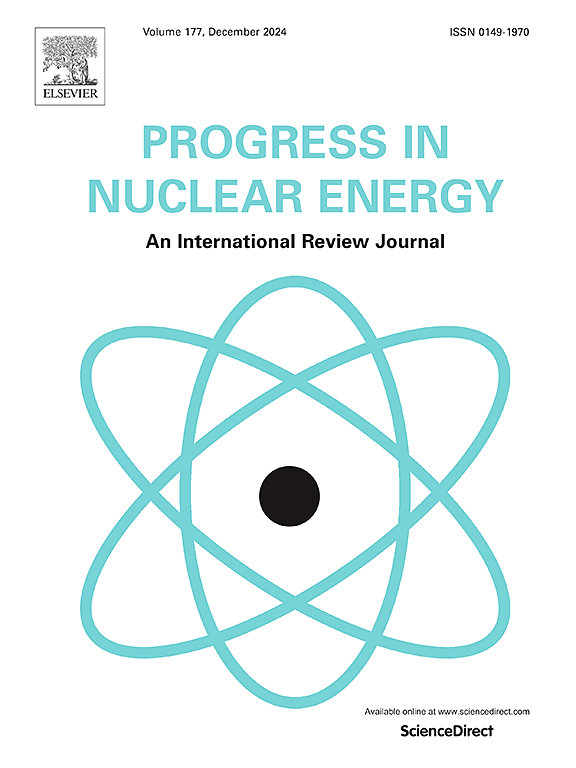Robust state estimation from partial out-core measurements with Shallow Recurrent Decoder for nuclear reactors
IF 3.2
3区 工程技术
Q1 NUCLEAR SCIENCE & TECHNOLOGY
引用次数: 0
Abstract
Reliable, real-time state estimation in nuclear reactors is of critical importance for monitoring, control and safety. It further empowers the development of digital twins that are sufficiently accurate for real-world deployment. As nuclear engineering systems are typically characterised by extreme environments, their in-core sensing is a challenging task, even more so in Generation-IV reactor concepts, which feature molten salt or liquid metals as thermal carriers. The emergence of data-driven methods allows for new techniques for accurate and robust estimation of the full state space vector characterising the reactor (mainly composed by neutron fluxes and the thermal-hydraulics fields). These techniques can combine different sources of information, including computational proxy models and local noisy measurements on the system, in order to robustly estimate the state. This work leverages the Shallow Recurrent Decoder (SHRED) architecture to estimate the entire state vector of a reactor from three, out-of-core time-series neutron flux measurements alone. Specifically, the Molten Salt Fast Reactor, in the geometry of the EVOL (Evaluation and Viability of Liquid Fuel Fast Reactor System) project, is demonstrated as a test case, with neutron flux measurements alone allowing for reconstruction of the 20 coupled field variables of the dynamics. This approach can further quantify the uncertainty associated with the state estimation due to its considerably low training cost on compressed data. The accurate reconstruction of every characteristic field in real-time makes this approach suitable for monitoring and control purposes in the framework of a reactor digital twin.

核反应堆浅层循环解码器部分堆外测量的鲁棒状态估计
可靠、实时的核反应堆状态估计对核反应堆的监测、控制和安全至关重要。它进一步增强了数字双胞胎的开发能力,这些数字双胞胎对于现实世界的部署来说足够准确。由于核工程系统通常以极端环境为特征,因此其堆芯内传感是一项具有挑战性的任务,在以熔盐或液态金属为热载体的第四代反应堆概念中更是如此。数据驱动方法的出现,使人们能够采用新技术,对表征反应堆的全状态空间矢量(主要由中子通量和热工水力学场组成)进行准确和稳健的估计。这些技术可以结合不同的信息源,包括计算代理模型和系统的局部噪声测量,以鲁棒估计状态。这项工作利用浅循环解码器(SHRED)架构,仅从三个堆芯外的时间序列中子通量测量中估计反应堆的整个状态向量。具体来说,在EVOL(液体燃料快堆系统的评估和可行性)项目的几何结构中,熔盐快堆被证明是一个测试案例,仅用中子通量测量就可以重建动力学的20个耦合场变量。这种方法可以进一步量化与状态估计相关的不确定性,因为它在压缩数据上的训练成本相当低。该方法能够实时准确地重建各特征场,适用于反应堆数字孪生框架下的监测和控制。
本文章由计算机程序翻译,如有差异,请以英文原文为准。
求助全文
约1分钟内获得全文
求助全文
来源期刊

Progress in Nuclear Energy
工程技术-核科学技术
CiteScore
5.30
自引率
14.80%
发文量
331
审稿时长
3.5 months
期刊介绍:
Progress in Nuclear Energy is an international review journal covering all aspects of nuclear science and engineering. In keeping with the maturity of nuclear power, articles on safety, siting and environmental problems are encouraged, as are those associated with economics and fuel management. However, basic physics and engineering will remain an important aspect of the editorial policy. Articles published are either of a review nature or present new material in more depth. They are aimed at researchers and technically-oriented managers working in the nuclear energy field.
Please note the following:
1) PNE seeks high quality research papers which are medium to long in length. Short research papers should be submitted to the journal Annals in Nuclear Energy.
2) PNE reserves the right to reject papers which are based solely on routine application of computer codes used to produce reactor designs or explain existing reactor phenomena. Such papers, although worthy, are best left as laboratory reports whereas Progress in Nuclear Energy seeks papers of originality, which are archival in nature, in the fields of mathematical and experimental nuclear technology, including fission, fusion (blanket physics, radiation damage), safety, materials aspects, economics, etc.
3) Review papers, which may occasionally be invited, are particularly sought by the journal in these fields.
 求助内容:
求助内容: 应助结果提醒方式:
应助结果提醒方式:


